Our World in the 7th Century A.D.
Sometimes this question will randomly pop in my head, "What are other people around the world doing right this second?"; it's an interesting thing to think about. It occurred to me that was an interesting idea to apply to history. For example, while the Sui Dynasty was collapsing in China, what was going on in Canada? While the Mayans were performing human sacrifices, who were the Vikings raiding? When Braveheart was getting beheaded was Kublai Khan wiping his butt? These are burning questions that need answering.
So basically I thought it would be interesting to choose a specific time period and look at what was going on globally. I'm currently studying early medieval China so I thought I'd pick the 7th century, 600-700 A.D.
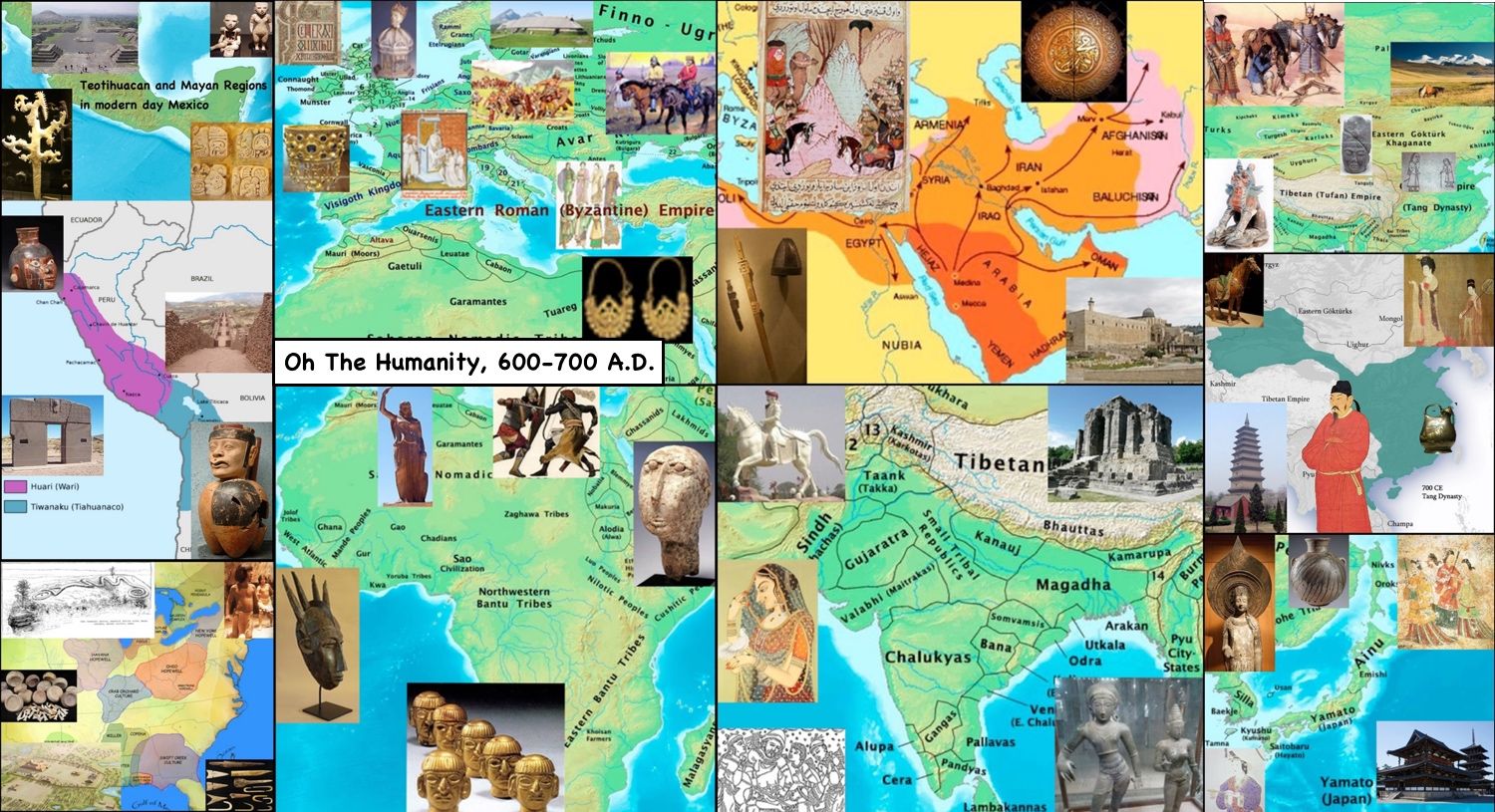
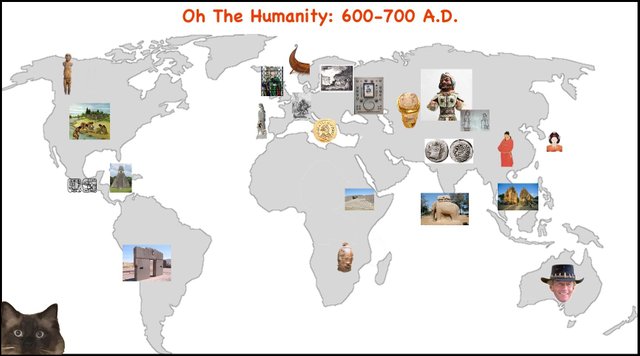
Made two maps. Decided to keep both.
I'll organize this by region, listing interesting facts about the people or culture. It's interesting the variance in detail of historical records by location. Areas close to where human civilization began: Europe, middle east, central asia, you have documented historical records, while in America and Africa you have to rely mostly on artifacts and geological data to determine the cultures and timelines.
China
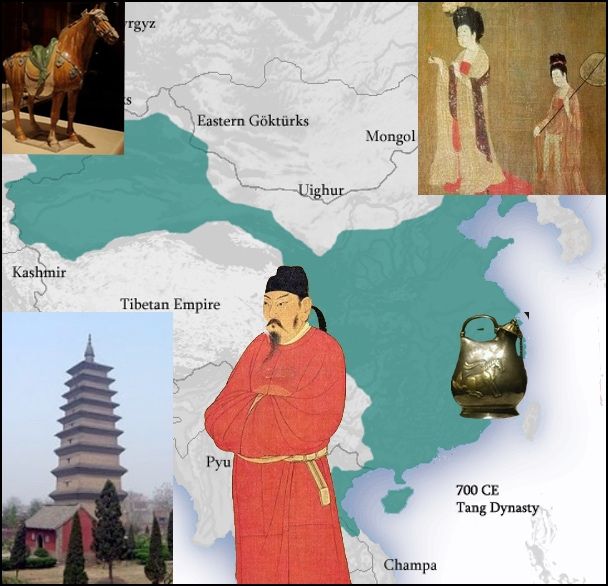
The Tang Dynasty was started by Gaozu after the Sui collapsed(blowing all their cash on failed military exploits). Success of the Tang was mainly due to Emporer Taizhong, son of Gaosu, regarded by most as the greatest dynastic ruler in Chinese history. He did this by basically just being a rational dude.
Cultural achievements: Largest civilization in the world, first printed book, golden age of poetry, advanced criminal code, opera, porcelain, metalwork, clockwork. This is way above most other cultures at the time and for hundreds of years.
Population was about 50 million people. "Fun" fact - it would have been a lot more, but it was cut in half by the wars of the Three Kingdoms period a couple hundred years before.
Buddhism was made the state religion for the first time.
Chang An, currently known as Xian, was the largest city in the world with a population of 500k - 1 million.
North America-600-700 A.D.
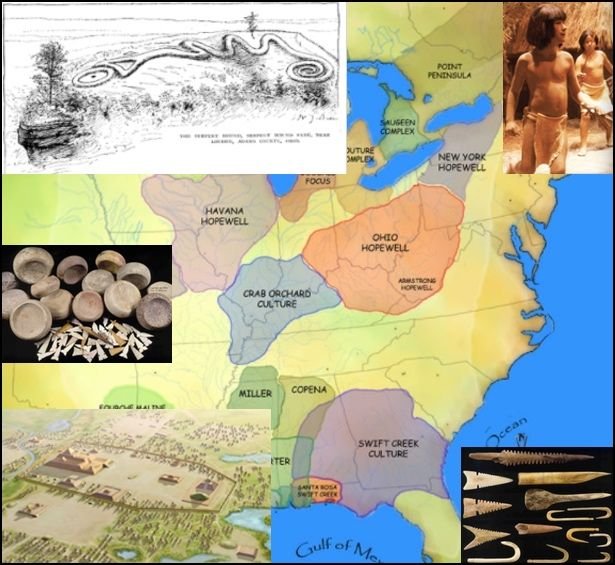
The eastern United States was in the Later Woodland Period of Hopewell culture. These were hunter-gatherers on the verge of developed farming. There were small groups of hunter gatherers roaming around most of what is now the USA and Canada.
Cultural achievements and characteristics during this period: bow and arrow, burial mounds, sport, tempered pottery with decoration, wigwams and longhouses. No written history.
Population about 4 million(less than the population of modern San Francisco)
Europe-600-700 A.D
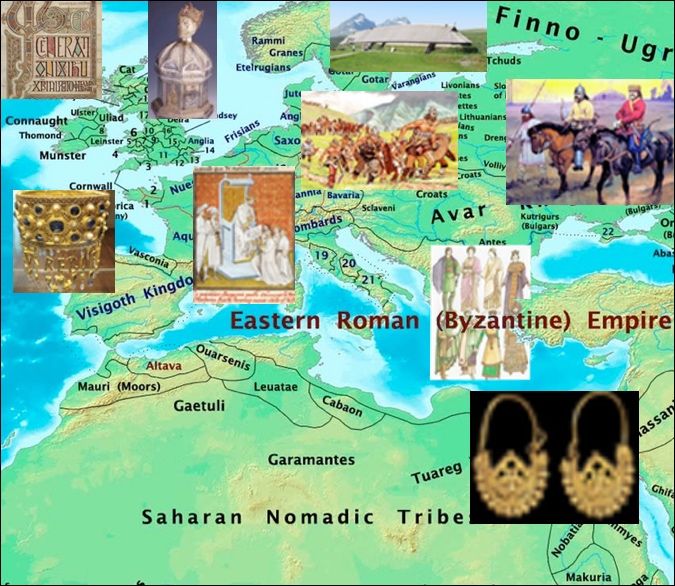
A lot to cover here so I'll try to keep it as simple as possible.
Population about 20 million(population of modern New York or Shanghai)
Byzantine Empire: This is what was left of the Roman Empire after Italy was overrun by the Ostrogoths, who had been supplanted by the Lombards in Italy by the 7th century. It consisted of parts of Greece, Turkey, Bulgaria, Egypt, and a smidge of Italy. Heraclius, emporer at the time, and his dynasty were Armenian in ancestry. It was an advanced culture, with art, literature, and Roman technology, but like any at the time, still brutal, they were mainly at war with the Persians. The emperor at the time, Heraclius had many political opponents blinded, castrated, or subject to nose, hand, or leg amputations. Including his son, who tried to overthrow him, but in the end his rebellion didn't have a leg to stand on.
Spain at the time was ruled by the Visigoths, germanic people. Interestingly, the Spanish language didn't exist there until the 10th century. Conquering muslims took Spain from the Visigoths the following century. There is virtually no trace of the Visigoth culture in modern Spain, besides the weird kids in school that wear black eye liner. They were pagans, not christians, and one interesting thing that remains of the Visigoth culture in modern Spain is some of their law code giving women property rights.
The UK was split into many different kingdoms and had a population between 1-2 million. The UK was a mess since the Romans left the 5th century. The Germanic Angles and Saxons invaded and wiped out a lot of people, in fact the population during Roman occupation, before the chaos, was over 2 million. During 7th century, the area was largely converted to Christianity and became split into the Anglo Saxon regions of Northumbria, Mercia, Anglia, then the Picts in Scotland.
Irish history wasn't documented until the beginning of the Christian period in the 6th century. There wasn't much outside interaction until the Vikings invaded and conquered a hundred years later. It was all Gaelic at the time with a clan/chieftain system. The Gaelic history was orally preserved until the introduction of literature in the 6th century by the Christian Missionaries.
The vikings weren't around yet, Scandinavian people at the time were just clans that apparently really liked cold weather. It was the next century in which they learned to build boats and they discovered they also really liked killing and stealing.
France and much of Western Europe was ruled by the Franks; Germanic people who are seen as the forebears of most Europeans, French, Germans, Dutch, Austrians. During the 7th century, the Frankish Realm was divided into a handful of Kingdoms like Aquitaine and Ron Burgundy. Chlothar II reunited them under his rule. Most spoke variants of German and Dutch. Modern French started later in a small area of what is now Northern France and Belgium, and evolved from the previous mix of Roman and the local people's colloquial dialect at the time.
Eastern Europe, the Baltics, Russia, were at the time populated with the Slavs, Bulgurs, and Avars. They preceded the Rus peoples that became Russian, Poland, Ukraine, etc. The Slavs were pagan tribes, the Avars were horse raiders from the southeast, that basically were like the Vikings of the area. Not very nice with all their raping and pillaging. The slavs through interaction became horsemen as well. The Avars origins are not known for sure. What is known is that besides raiding for themselves, they acted as mercenaries for the Byzantine Empire, until they turned on them as well. Guess who stopped their shenanigans? The French! Who would've thought. Although really the French were mostly German at the time. We'll give it to them since they were all called "Franks".
Got all that?
South America and Mexico-600-700 A.D
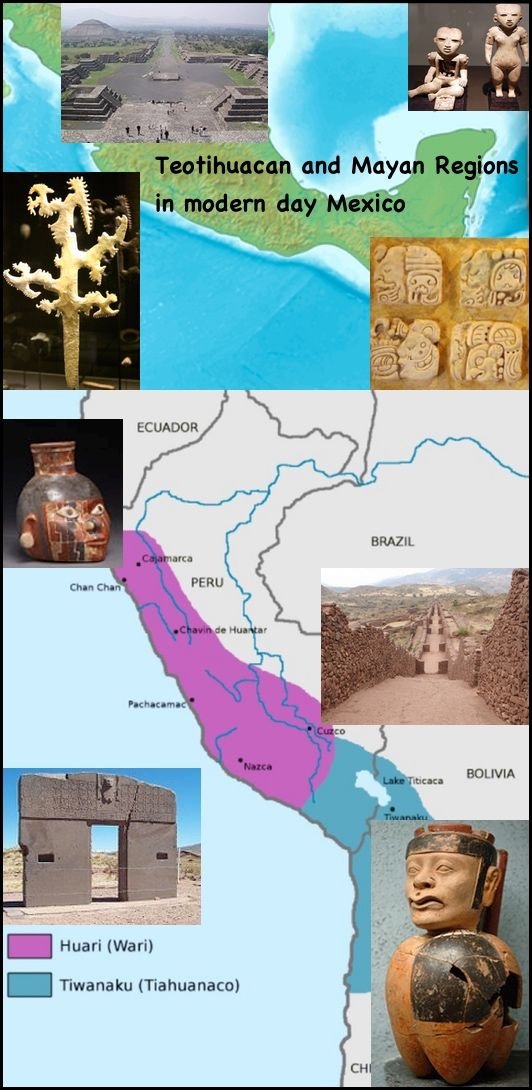
Population - 4 million in Mexico, 3 million in South America.
7th Century was the peak of Mayan Society. Mayans, on the Yucatan Penninsula, had an advanced written language, not just symbols(the only group in the Americas of this time period that did), art, mathematics, and astronomical system. Of course, they also liked war and they performed human sacrifices by cutting the still beating heart out of victims, as well as by torture and decapitation. So you take the good with the bad.
In South America there were the Wari and Tiwanaku Cultures, which were antecedents to the Incan Empire(The Incan Empire peaked in the 15th century). The Tiwanaku used the resources of Lake Titikaka, fish, birds, plants. They herded llama and Alpaca and also ate potatoes, quinoa, beans, and corn.
Note- All around North and South America, besides the specific sites mentioned, there were small groups of hunter gatherers for which there is very little historical data, but they also contributed to the population numbers mentioned above. The big cities of the Mayans, Tiwanaku, and Wari typically had no more than 100,000 residents.
India-600-700 A.D

- India at the time had the world's largest economy, 1/3-1/4 of the world's wealth.
- Population over 50 million, more than Tang China or anywhere else at the time. However, the population of Tang China was the largest population under one ruling empire.
- From this period South India started a shift from smaller kingdoms to larger empires, like the Chalukya, Pallavas, and Penyas. This brought advancements in government administration, overseas trade, and architecture. It was a golden age of South India.
- Temples of Hinduism to gods like Vishnu were excavated sandstone, essentially sculpted from stone already at that location.
- Sanskrit, the oldest Indo-aryan language was spoken mostly in the North, while Tamil was spoken mostly in the South. Both are thousands of years old written languages, predating our modern systems.
Mongolia and Siberia-600-700 A.D
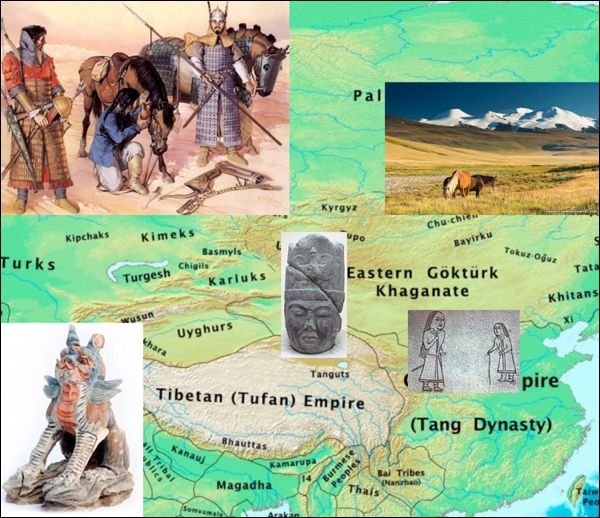
- Between the vast Mongolian step plains and Siberia's frozen tundra, the step tribes formed from nomadic east and central asians, as well as some eastern europeans. From 1st millennia B.C. through the 15th century were a dominant force of mostly nomadic tribes of horse warriors occasionally uniting to wreak havoc on the surrounding peoples.
- By the 7th century, many tribes had coalesced and the gokturk culture came to dominate the step plains north of China, reaching through Russia, eastern Europe, and towards Iran.
- They were raiders and mercenaries, often used by Chinese militaries and many times the decisive factor for victory. They were, however, completely unreliable and would often rape and pillage the cities that they were supposed to be fighting for.
- Over the millennia they had blended with the Chinese to a large degree. Interestingly, when looking at the whole of ancient history, it was the step tribes that were generally victorious over Imperial China. Chinese military was not successful using traditional warfare in the harsh environment of the north against the more mobile calvaries of horse warriors. The step tribes like the gokturks never tried to control much of China, however, with the exception of some Northern kingdoms, and of course the Mongol Empire which lasted a hundred years or so around the 13th century(the time of Ghengis Khan).
- Even young girls were trained with horse and bow as children.
- Ruling class members often took Chinese names and spent time in Chinese capitals. Chinese would send women to them for marriage alliances so they would stop raiding Northern Chinese towns.
Africa-600-700 A.D
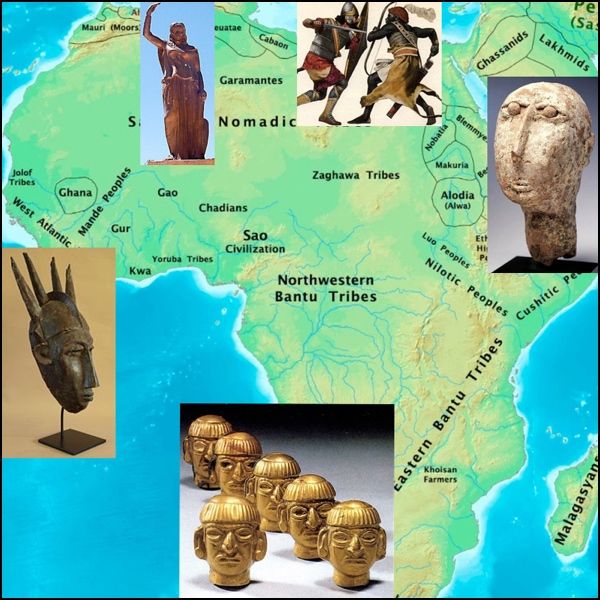
- Population was about 15 million.
- Languages included Nilo-Sara of Nubia and West Africa, Coptic/ancient Egyptian in Egypt(not like modern Egyptian/Arabic), and Bantu(antecedent of Zulu) in the South.
- In the north people were skilled with copper, bronze, and iron. Jewelry, pottery, coins, eating utensils, etc.
- Islam started to reach Eastern and Northern Africa during the 7th century as the Muslim Empire started to invade and conquer surrounding areas.
- The Arabs also began the slave trade in 7th century, transporting across the Red Sea, Indian Ocean, and Sahara Desert.
- The southern Bantu peoples were iron-using agriculturists and herdsmen at the time, mostly unaffected by the chaotic goings on of the North.
Middle East-600-700 A.D
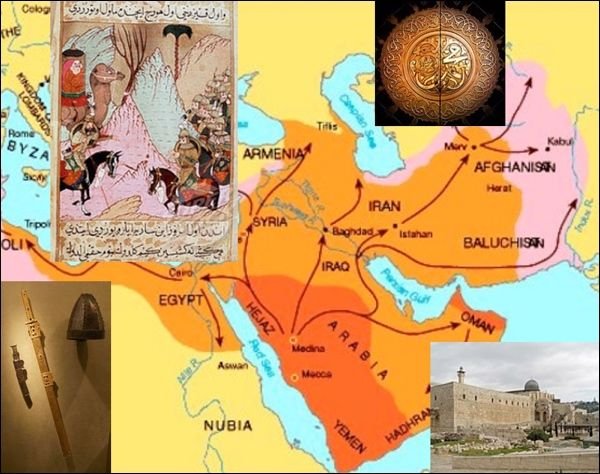
- Languages spoken at the time were Arameic and Greek(language of Byzantine Empire). Arabic was not spoken until the 8th century.
- The 7th century was huge for the middle east, it was a time of unification and expansionism. Muhammad the prophet of Islam appeared and unified the Arabian Peninsula by 632. Unified under Islam, this paved the way for the Umayyad Caliphate to form after Muhammad and conquer Iran, central asia to the borders of China, Northern Africa, and even Spain by mid 8th century.
- The Muslims were mainly able to conquer due to their unification under Islam and the weakness of the surrounding empires, the Byzantine and Persian, after they had been warring against each other for many years. It all disintegrated by the end of the 8th century though.
- Interestingly, within the Muslim Empire, non-muslims were free to practice their own religion, as long as they acknowledged their second class citizenship.
Japan-600-700 A.D
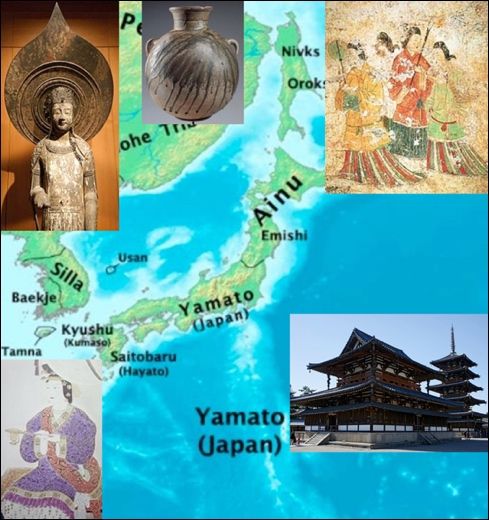
- During the Asuka period of medieval Japan. Population was about 4 million.
- Buddhism first entered Japan during this period.
- Japan experienced a military defeat by Tang China joined by Scilla(early Korean Kingdom). This was well before Japan's Samurai strong military period, and this loss inspired Japan to start reformations of their military.
- Japan adopted Tang China style government administration during this period.
Australia

- Population - Everyone was too drunk to count.
- Paul Hogan filmed Crocodile Dundee 2.
- Men At Work's "Land Down Under" became the national anthem.
- Just kidding, nothing important happened. Kind of like modern times, really.
Again, what I find most interesting is to think of all these things in a global context; so many wildly different landscapes and cultures, and in those medieval times, in a constant state of turmoil. It's very entertaining to imagine the trials and tribulations, adventures, and struggles of our ancestors, as evidenced by our love of Game of Thrones and Vikings, etc., but of course to really picture yourself in such brutal times is hard for us to comprehend(for most of us, sadly not all). Beneath the chaos and terrible brutality of history, you can also see human ingenuity and progress, and hope that all the suffering is not in vain.
Done. I've spent longer on this post than most of my other ones combined. That was hard work. I hope you learned something. Who knows, maybe I'll do another one of these someday, but not for awhile. I'm almost sick of using Pixelmator. Haha, not really, I can't get enough Pixelmator.
I'm sure some of this will need corrections, feel free to comment about it.
*Also I apologize to any Australian readers. Don't punch me, I know you guys are violent.
Sources
Ok, so I fully support giving credit to sources. However, this is a fun thing and not a published book. I looked at a hundred wikipedia articles, and each one of those had a hundred sources. If I tried to write them all down here the blockchain would cry, and we wouldn't want that. I got the pictures mostly from Wikipedia and some from Pinterest or museum/park websites.
I'll compromise; Whatever this post makes, I'll donate 10% to Wikipedia. The kind of people who look at bibliographies(weird), will check out the wiki articles and see some of the true sources. Call me lazy, I welcome your hate. That's how it's gonna be, you can't stop me. Please don't flag me, I will provide proof of the Wiki donation as a future edit to this post. UPDATE: I donated $10 to wikipedia two days ago, but they still haven't sent me a receipt.
I did do all the map collages myself.
The End.
Please follow me, I'm needy. Here are a few of my posts that I think are, like me according to my mom, special.
- Engineering:https://steemit.com/business/@cryptastic/a-factory-audit-inside-china-hardware-sourcing
- Game Review: https://steemit.com/games/@cryptastic/game-review-the-game-seriously-it-s-called-the-game
- Steemit: https://steemit.com/steemit/@cryptastic/honey-i-got-500-followers-that-s-great-dear-can-you-clean-the-cat-s-litterbox-now
- Fiction: https://steemit.com/writing/@cryptastic/a-game-of-thrones-story-the-dragonstone-mixup-spoilers
- Game Review: https://steemit.com/gaming/@cryptastic/game-review-inis-a-game-of-celtic-history-and-lore
- Game Review: https://steemit.com/games/@cryptastic/game-review-star-wars-card-game
- Chess: https://steemit.com/chess/@cryptastic/chess-class-3-the-petrov-defense-or-russian-game-and-memorization-technique

Wow, I really hope you make a series of these. Truly fantastic post.
Especially "He did this by basically just being a rational dude."
Where can we get one of those?
haha, well Dynastic China only had like 2 in 500 over the course of 3000 years, so there are your odds. Unfortunately for humanity, empathy isn't a very strong instinct. Big flaw in our design.
Easily one of the handful of best posts that I have read on Steemit in my 52 days on the platform. I am so glad you found my super duper upvote and resteem service! This is a resteem WELL EARNED my friend. I am a dungeon master so of course I spend a lot of time doing pretty much this exact kind of thing but for a fantasy world. I draw heavily on real world history though because real life is always a lot weirder and cooler than fantasy, as a general rule of thumb. Reading this post got me wanting to start up an "Earth 666 AD" low magic D&D game. I have gamer ADD. Bad brain, down.
Anyway this was a great read, terrific job synthesizing what I know had to be many hours of research down into a focused and easily digestible morsel for each of your regions.
Two notes - is it an omission or were you just unable to determine the population of Mongolia and Siberia-600-700 A.D? I was actually particularly curious about the relative population there vs. China so I noticed that it was missing.
Second I have done a lot of research on pre-contact South America and I think you are wildly underestimating the population there at the time. Would be happy to share some sources there if you want.
Cheers - Carl
Hey thanks man. First, I'm a big fan of RPG myself, I just finished a Star Wars edge of the empire campaign. I've seen some folks try to do one on Discord, but it kind of seemed like a mess. Still I'd be interested in a Discord game.
It was actually an omission for the population of Northeast Asia. Any information I can find now suggests less than a million, and in fact the population of Mongolia today is only 3 million. There's a really cool website about population I found: http://worldpopulationhistory.org/map/712/mercator/1/0/25/
Bring the corrections on, I'd be happy to know more about S. America. I was actually expecting a lot more by now. I'm not a real historian so I knew I'd get something wrong.
Nice to meet you, let's stay in touch.
I liked the point of your article. I am glad to see that there are more people who ask themselves something and feel the need to look for information until the doubt is partially resolved. I say partially why we are almost never able to answer 100% of the questions we ask ourselves. What makes it even more exciting.
I am also happy to read about the so unknown oriental cultures in the Western World.
Well said, thanks.
In this centry, the world's population shrinks to about 208 million people.
Yep, you're right, thanks.
This is BRILLIANT!! Yes! This is why I love history, so much was happening, like little universes in different geographic areas and then they start to connect and there's so much drama and suspense and plots!! I can imagine you took a LONG time putting this together, thank you, I really enjoyed jumping all over the world and "herding" all those facts into one period of time.
(Suggested edit: Mohamed was a "prophet" not a "profit" $)
Thanks, it did take a lot of time, but it was worth it. I realized that you learn more when you're trying to create a project like this than if you're just reading about history. I think the information will stick with me better. Good catch on the "profit". You can tell I've been focusing on crypto too much.
Thanks for taking so much time on this post, we usually look at a single country at a specific time and never appreciate what is going on concurrently so thank you for this info as well as for the concept \o/
You're welcome!
really amazing post u describe very well upvoted and followed u hope u will do the same
https://steemit.com/food/@sanasara/7-diet-foods-to-lose-weight
will do, thanks,
Your post is awesome
Thank you.
This is a fantastic post- you should keep doing these for more centuries! (The 1300s are especially eventful.) I've spent years studying world history, and I still have trouble keeping a lot of it straight. Posts like these would be great resources for people just getting into world history. (Just as a self plug- I actually literally just posted a list of good books to read to start studying world history. I always feel really awkward promoting myself, but it's super relevant this time around.)
Don't feel bad, I've done it before, and thanks for the compliment. I'll definitely do another one, and next one will be 1300s!
Congratulations! This post has been upvoted from the communal account, @minnowsupport, by cryptastic from the Minnow Support Project. It's a witness project run by aggroed, ausbitbank, teamsteem, theprophet0, someguy123, neoxian, followbtcnews/crimsonclad, and netuoso. The goal is to help Steemit grow by supporting Minnows and creating a social network. Please find us in the Peace, Abundance, and Liberty Network (PALnet) Discord Channel. It's a completely public and open space to all members of the Steemit community who voluntarily choose to be there.